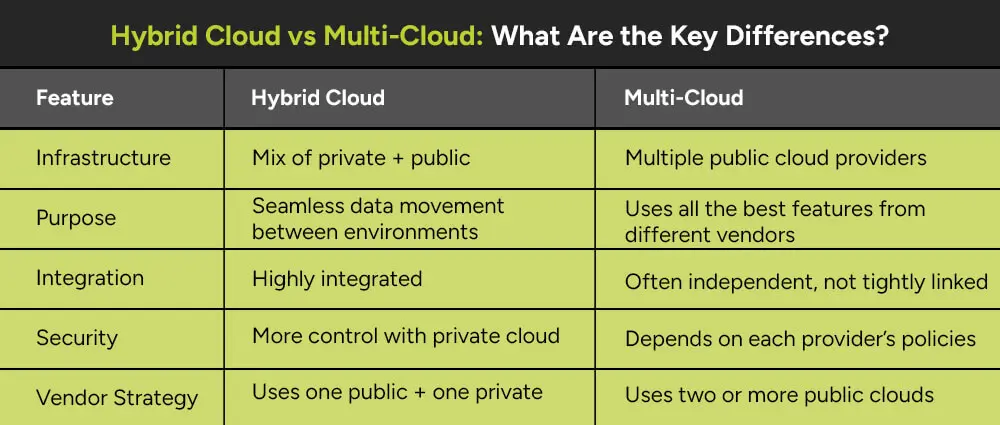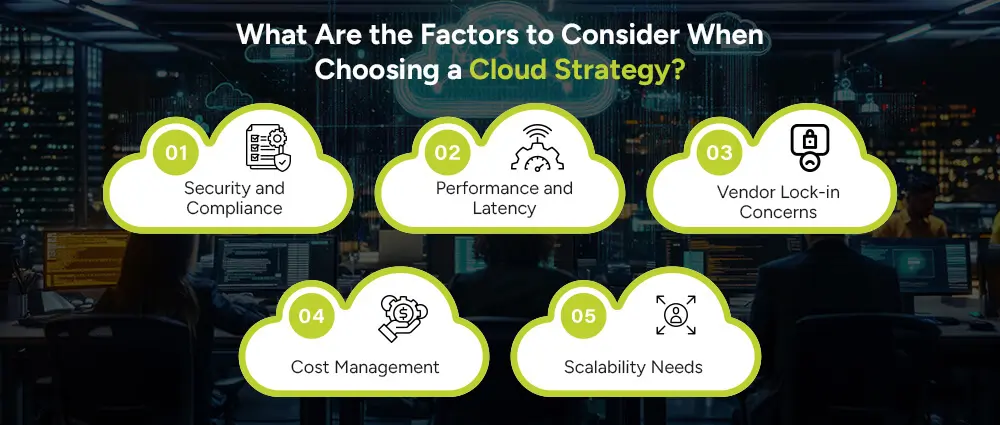The US cloud computing market is projected to grow up to 639.9342 billion by the year 2030. It has been a great turning point for businesses of all sizes. But with great power comes… well, a lot of options.
If you’ve been researching cloud strategies, you’ve probably stumbled across two terms that seem similar but are actually quite different: multi-cloud and hybrid cloud. So, what is multi-cloud vs hybrid cloud? Let’s break it down.
Multi-cloud can be loosely analogous to visiting different stores for different items, groceries from one, clothes from another, and the latest electronics from yet a different store. The multi-cloud concept refers to using two or more cloud services from different service providers at the same time, such as simultaneously using AWS, Microsoft Azure and Google Cloud Platform. The ultimate goal is to get workloads distributed across multiple vendors in order to avoid reliance on any single provider, reduces risk, or even choose services from each provider that best meet business requirements.
In short, multi-cloud refers to the use of multiple public cloud providers, which is typically done to avoid vendor lock-in, and it will also help in optimal performance and cost.
Now let’s say you have your own personal garden, which in this sense is your private cloud, but sometimes you also visit a local farmer’s market for seasonal fruits, which here is called the public cloud. That’s the essence of a hybrid cloud.
A hybrid cloud combines a private cloud, on-premises or hosted, with one or more public clouds, all working together. This setup lets data and applications move seamlessly between the two environments, which is great for flexibility and scalability.
In short, a hybrid cloud is a mix of private and public clouds, offers better data control and flexibility, and is ideal for companies with sensitive data that still want cloud scalability.
When it comes to cloud cryptography, both strategies involve multiple cloud environments, but they’re not the same. Let’s look at the hybrid cloud vs multi-cloud debate side-by-side:


When managing multiple businesses and departments, it’s hard to decide what type of cloud and cloud infrastructure management should be employed to ensure business success. So, which one should you choose? That depends on a few factors, like:
Handling sensitive data like healthcare cloud migration or financial records? A hybrid cloud might be better due to the private cloud option.
Do you want to minimize lag? Multi-cloud can help place workloads closer to end users by leveraging different data center locations.
Many businesses work with many providers or consulting companies because they don’t want to depend on just one provider. Multi-cloud is your best bet here, multiple clouds, no loss of data ever!
Both can help manage costs, but multi-cloud may give you more pricing flexibility by playing vendors against each other.
If you’re expecting to scale quickly, hybrid cloud can offer a solid mix of on-demand public cloud resources with the consistency of private infrastructure.
The terms hybrid cloud and multi-cloud are sometimes interchangeable but they indicate different almost-alike methodologies for cloud computing: with the hybrid cloud, organization can combine an on-premises/private cloud setup with one or more public clouds affording flexibility and control over where and how data and workloads are handled, while multi-cloud indicates the use of more than one public cloud provider at the same time, often so that it can take advantage of strengths from each provider or to avoid being locked into a single vendor.
One of the most common example of a hybrid cloud is to manage data residency and compliance. For instance, healthcare or finance organizations might have to store information like patient records or customer data in a private cloud due to regulatory requirements, while using public clouds for processing other less sensitive data or running applications. Cloud bursting is another great hybrid scenario. For example, taking a retail enterprise that has the majority of its website traffic directed to the private servers but “bursts” that additional demand into the public cloud during busy shopping seasons, such as on Black Friday, to avoid bottlenecking.
Hybrid clouds will benefit organizations that are website migrating to the cloud in a staggered manner. Instead of migrating all applications and data at once, organizations can keep their core systems in their data centers and slowly migrate non-critical applications to the cloud as required. For larger organizations, this tends to be a more pragmatic approach. Additionally, some organizations use hybrid clouds in a disaster-recovery scenario to keep a backup copy of the most critical systems in the public cloud, ensuring the quickest possible recovery of operations should their private datacenter ever go down.
Multi-cloud comes in handy when organizations seek to shift their dependence from a monopolistic reliance on a single cloud vendor. For instance, an organization might use Amazon for HIPAA-compliant cloud storage, take Microsoft Azure for enterprise tools, and depend on Google Cloud for all of their machine learning capabilities. Such an organization is taking advantage of the superior services that each provider has to offer without limiting itself to just one vendor. Multi-cloud is at an advantage when an organization goes global, as such an organization may use different providers in different geographical locations, of course, to optimize performance or comply with local laws.
Another situation where multi-cloud is practical is after a merger or acquisition. If two companies each used different cloud providers before they came together, continuing to use multiple clouds might be more efficient than migrating everything to one platform. Overall, the role of cloud managed services, especially multi-cloud, gives companies flexibility and resilience by spreading their resources across different platforms, but it also requires strong management to keep everything working smoothly.
In short, hybrid cloud is often about integrating private and public environments to increase control and flexibility, while multi-cloud is about using several public cloud providers to stay agile and avoid limitations. Some organizations even combine both strategies, connecting a private cloud to multiple public ones, so they can get the best of both worlds.
If your hybrid cloud setup connects your on-premises environment (or private cloud) with more than one public cloud provider, then it is both a hybrid cloud and a multi-cloud.
Example:
This setup is:
Choosing between multi-cloud vs hybrid cloud isn’t just a superficial thing, it’s about your business goals, challenges, and future plans. Whether you want the control of a hybrid setup or the versatility of a multi-cloud environment, understanding the differences will help you make the right call when you’re thinking about going between public cloud vs private cloud vs hybrid cloud.
Also, if you end up using both? You’re in good company. Many businesses are going hybrid and multi-cloud to get the best of both worlds. Want to know which way to go? Leave us a message at Arpatech and let the experts take the reins on what direction you want your business to go.
Yes! A hybrid cloud can include multiple public clouds along with a private cloud. In that case, it’s both hybrid and multi-cloud, combining the best of both worlds.
The common features of hybrid and multi-cloud are:
The best cloud consulting companies will give you the reasons of hybrid and multi-cloud usage. Here are some: